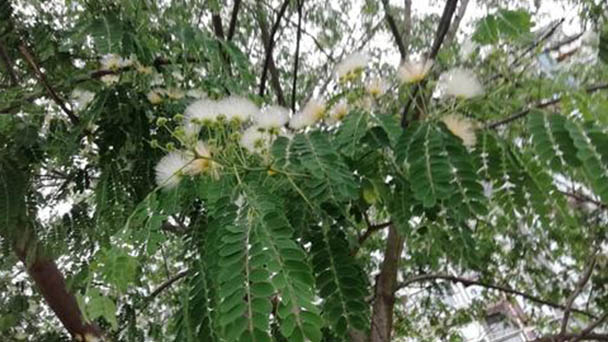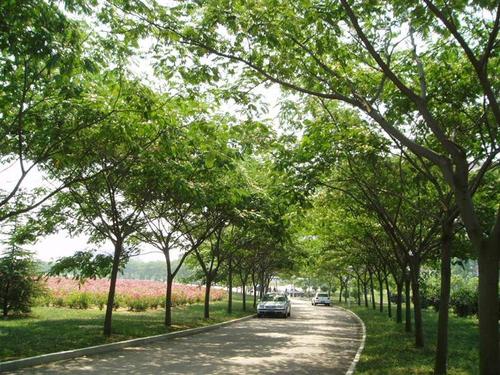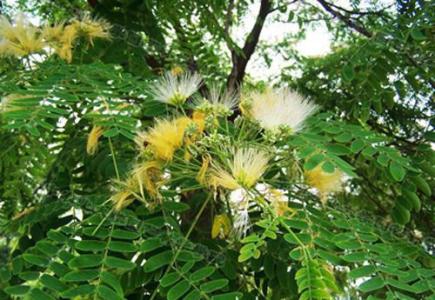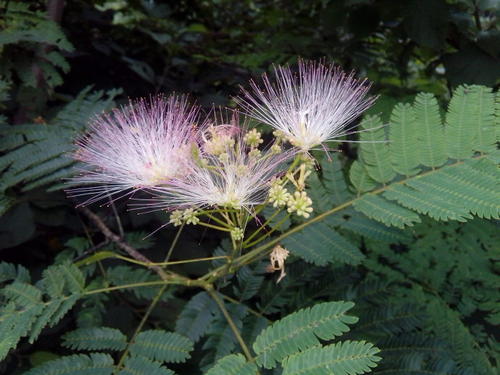Albizia kalkora (Kalkora Mimosa) profile
Written by Maggie
Aug 31 2021

Albizia kalkora, also called Kalkora Mimosa, is a medium tree, usually 3-8 m tall. Branches are dark brown, pubescent, there are significant lenticels. Albizia kalkora has double pinnate compound leaves, 2-4 pairs pinnate, leaflet apex rounded obtuse and apiculate, pubescent on both sides, midvein slightly to the upper side. Flowers are white, corolla densely pubescent. The pod is flat, dark brown, sparsely pubescent.
Albizia Kalkora is characterized by fast growth, the ability to withstand drought and barren soil, and resistance to water and moisture. albizia kalkora is widely distributed in North China, Northwest China, East China, South China to the southwest provinces. Born on the slopes of thickets, sparse forest. Vietnam, Burma, India are also distributed.
Albizia Kalkora picture

Morphological characteristics of Albizia Kalkora
The trunk
Albizia kalkora, small deciduous trees or shrubs, usually 3-8 m tall. Branches are dark brown, pubescent, there are significant lenticels.
Leaf
Leaves of Albizia kalkora bipinnate, pinnacles 2-4 pairs, leaflets 5-14 pairs, oblong or oblong-ovate, 1.8-3.5 cm long, 7-17 mm wide, apically obtuse and apiculate, base unequal, pubescent on both sides, midrib slightly to upper.
Flowers
Albizia kalkora: Flower heads are 2-7 in axils or panicles on branch tops. Flowers are white at first, then yellow, with distinct peduncles; Flowers are glance tubular, 2-3 mm long, 5-toothed. Corolla of Albizia kalkora is 6-8 mm long, connate below middle tubular, lobes lanceolate, flowers, corolla are densely pubescent; The stamens are 2.5 -3.5 cm long, connate at base and tubular.
Fruit
The pod is banding, 7-17 cm long, 1.5 -3 cm wide, dark brown, tender pods densely pubescent, glabrous when old. Albizia kalkora has 4-12 seeds, obovate.
Ecological habits of Albizia Kalkora
Albizia kalkora is a light-loving plant with well-developed roots. Albizia kalkora grows on laterite, red soil, purple soil and alluvial soil. Albizia kalkora can also grow in poor mountainous areas, but it grows more slowly.
Albizia Kalkora's region of distribution
Albizia Kalkora is distributed in North China, East China, South China and Southwest China. The main distribution of provinces have Hubei, Henan, Shaanxi, Gansu, Sichuan, Guangdong, Guangxi, Jiangsu and other provinces, Vietnam, Myanmar, India also have distribution. The altitude of distribution is 1100-2500 meters.
Albizia Kalkora propagation
Seed propagation
Albizia Kalkora seed reproduction has the following advantages: seed size, lightweight, easy to harvest, transport and long-term storage; The seed source is wide, the sowing method is simple, easy to master, easy to multiply; The seedling root system is developed, the growth is vigorous, the life span is long; But there are some late flowering and fruiting; Progeny is easy to mutation, thereby losing the original good traits and other shortcomings.
Grafting propagation
Grafting of Albizia kalkora could not only preserve the excellent characters of Albizia kalkora, enhance its ability to adapt to the environment and make trees gain early returns, but also be an important way to breed new crop varieties. Grafting is divided into two kinds: bud grafting and graft grafting. Bud grafting is grafting with a bud as a scion. The stock requirements are not thick, annual seedlings can be used as rootstocks for budding; The operation is simple, easy to master, and the survival rate is high. Bud grafting can be divided into bud grafting, sentinel grafting, tube grafting and eye grafting due to different forms, among which bud grafting is the most widely used. Grafting is the grafting of a scion with a branch. When grafting on Albizia kalkora and other woody plants, the grafting time was mostly chosen during the "Awakening of Insects" and "Grain Rain" seasons, when the trees began to germinate but not yet. The survival rate of grafting is high and the growth is fast after grafting, but the stock should have a certain thickness and the grafting time is also limited. Due to the different forms of grafting, it can be divided into split grafting, cut grafting, skin grafting and other different methods. Albizia kalkora is often propagated by grafting because of its different ornamental value and growth characteristics.
Cutting propagation
Cutting, also known as cuttings, is a common method of breeding plants. Albizia kalkora stems, leaves, roots, buds, etc. are cut off and planted in soil, sand, or water. After taking root, Albizia kalkora can be planted as a separate new plant. Commonly used are the following three cutting methods:
(1) Shooting is the cutting with leaves during the growth period of the plant (the rainy season is most suitable). Semi-mature Albizia Kalkora cuttings are selected to be fully developed and about 10cm in length. Each cutting should have two or three leaves so that they can photosynthesize to produce food and promote rooting. If the leaf is large, you can leave only one or cut off part of the leaf to reduce evaporation.
(2) Before the dormant period in autumn and winter or sprout in spring, the lignified Albizia Kalkora branches were cut and stored at a low temperature of about 5℃ for 20-40 days to break the physiological dormancy, and then inserted into the substrate to root and germinate. This method is also called hard cuttings.
(3) the thong. Albizia Kalkora can also grow new shoots from its roots. When the roots are cut into 5 to 10 cm cuttings and inserted into the substrate, they grow into new individuals.

Growing methods of Albizia kalkora
The emergence
Seeds sprouting on sowing in the first 10 days or so, with 70 ° C to 80 ° C hot water 10 ~ 15 minutes, stir slowly, then natural cooling, seed soaking for 24 hours, not the expansion of the seed soaking seeds can then use the above method, the expansion of seed disinfection in the 0.15% of potassium permanganate solution about 1 hour, remove dry, with 1% potassium permanganate solution disinfection, rinse off with clear water after disinfection, then mix mixed with seeds, sand volume ratio of 1:2 or 1:3, put it in a well-ventilated room temperature, indoor temperature around 10 ° C, and, turning on a daily basis, to check its water content, water content of sand will be subject to neighbors don't scatter, five days have seed fissure gradually, gap in embryo root, 10 days after seed about 40% gap, can be planted at this moment, if also sent a few days before it's time to sow, can put the seeds in pits in the low temperature hoard, cellar temperature control at 4 ° C ~ 5 ° C is advisable.
Sow
The first garden deep turn over again, and then make a bed, make a bed at the same time bottom fertilizer diammonium phosphate, the amount of 10kg per acre, if the use of diammonia base fertilizer, the amount of 50kg per acre. The bed width is 1.1m, the height is 25cm after the bed surface is suppressed, the foot water is filled, after the bottom water is infiltrated, the seed is sown again, to prevent the water in the seed from reverse osmosis, resulting in the seed water shortage and death. The sowing method adopts drill sowing, row spacing 10cm, soil thickness 1.5~2cm, sowing amount per acre 14.5kg, and then suppress, cover the reed curtain, keep soil moisture, prevent the surface hardening, avoid the burning sun, etc. Cover the reed curtain must be checked frequently, when a large number of seedlings unearthed, remove the reed curtain in time, so as not to cause yellowing or bending of seedlings.
Watering
After planting field management's main job is to control the water content of the seedling bed, watered once in the morning and after sowing, timely supply the necessary moisture after seed germination and emergence, rainy days when soil humidity is big, stop irrigation, because of too much water in the soil will rot the seeds, seedling root if in a wet environment, affecting the root respiration of Albizia kalkora, poor often growth or death, in addition, excessive irrigation not conducive to the growth of seedlings still can cause soil salinization. The high growth of Albizia kalkora during the rapid growth period accounted for more than 60% of the total growth of the whole year. The lateral branches and differentiation appeared in the aboveground part, and the complete root system was formed in the underground part. Therefore, it needs the most water, fertilizer and light. Seedling hardening period to stop watering, the purpose is to improve the degree of lignification of seedlings.
Weeding
Weeds are the enemy of seedlings. Weeds grow rapidly and reproduce strongly in nurseries, taking moisture, nutrients and light from seedlings. Some weeds are also the source of pests and diseases. Therefore seedlings of Albizia kalkora must remove weeds in time. But the labor intensity of artificial weeding is high and the work efficiency is low. In order to reduce labor intensity and improve work efficiency, mechanized weeding should be vigorously advocated. Timely soil loosening can improve soil temperature, increase air permeability, promote gas exchange, create suitable living conditions for soil microorganisms, utilization of soil available nutrients, and promote seedling growth.
Singling
When the nursery stock is too dense, the illumination is insufficient, the ventilation is bad, the nutrition area of each plant is small, and make the nursery stock grows weakly, the quality drops, susceptible to a disease insect pest. Thinning out sooner as Albizia kalkora seedlings 4 ~ 5 cm high, began between dense seedling and injured, bed planting seedlings every factor that leave after thinning seedlings 50 strains, bed planting seedlings leave seedlings of 150 plants per square meter, leave a number of should is 20% more than the number of plans to produce seedlings
Albizia Kalkora main value
Economic purpose
Wood: Albizia Kalkora is of excellent quality, medium hardness and softness, floral texture, easy to work, and very resistant to decay. Sapwood was light yellow, heartwood brown, and some were black brown. Albizia Kalkora is of high value and enjoys a high reputation in the world. Albizia kalkora is used for furniture and architectural decoration in mountainous areas in China. The decorative pattern on the surface of cabinets is comparable to that of suamach tree. Albizia Kalkora wood from Jilin Province of China was sold to Japan for 2000 yuan per cubic meter, more than double the export price of Paulownia (1983).
As fuel: Albizia Kalkora grows rapidly and sprout strongly. Cut the roots in winter the first year, and in the next spring, they can grow into clumps for germination. Up to a dozen, or as few as three or four, and the sprouts can grow to about 1.5-2 meters in length. If the head operation is carried out and the logging stakes are left for renewal, 3-5 strong sprout sticks can be left on each felling hood. After growing to a certain height, the tree crown can be restored to its original size in two or three years.So in terms of firewood, Albizia Kalkora has a very high yield.
Feed: Albizia Kalkora leaves, loved by livestock.If drying ground into powder, can be mixed to feed pigs and chickens rougage.
Ornamental purpose
Albizia Kalkora is a beautiful mangrove tree with graceful leaves. Albizia kalkora can be used as a garden shade tree or as a forest with bushes.
Medicinal uses
Root and stem bark of Albizia kalkora are medicinal, can replenish qi and promote blood circulation, detumescent and analgesic; The flowers are hypnotic, and the young branches and leaves can be eaten as wild vegetables.

Latest Updated
- Benefits of Bugleweed - 7 Science-backed Health Benefits
- Bugleweed Dangers & Side Effects - Is It Poisonous?
- How to Plant Evergreen Trees - What You Should Know
- When to Plant Evergreens - Grow Guide for Evergreen Trees
- 12 Wonderful Evergreen Shrubs for Your Garden
- 12 Popular Evergreen Plants with Pictures for Beginners
- When And How To Prune A Lilac Bush Like a Pro
- How to Grow & Care for Lilac Vine (Hardenbergia Violacea)
- Japanese Lilac Tree (Syringa Reticulata) Care & Propagation Guide
- Shumard Oak Pros and Cons - What to Know
Popular Articles
- Winter maintenance of Antirrhinum Majus
- How to Grow Terminalia Mantaly Tree
- How to Grow and Care for Crossostephium Chinense
- How to grow Antirrhinum Majus in spring
- Peristeria Elata (Dove Orchid) Profile: Info & Care Guide
- Underwatered Snake Plant (Sansevieria Trifasciata) - Signs And How To Fix
- How to Care for Brazilian Jasmine Plant (Mandevilla Sanderi)
- How to Grow & Care for Graptopetalum Purple Delight in Summer
- Rosa Chinensis (China Rose): Plant Growing & Care Tips
- How to Care for Baby Sun Rose (Aptenia Cordifolia)